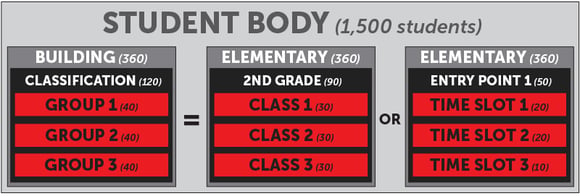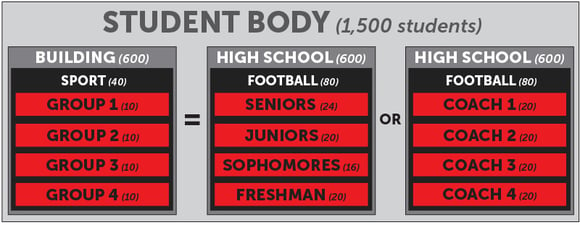Health and safety play an essential role in ensuring a secure educational environment and a productive learning experience. When health and safety are lacking, it’s pretty much impossible to learn. That’s why all districts need to make health and safety a top priority.
Blog
Here's how 250 schools completed 605,379 COVID-19 health screenings
We get it. Reopening plans are tough. There are contingencies upon contingencies. You're faced with requirements, recommendations, and a polarized public.
We're here to help you set the basic foundation for a process every school will either nail or fail this Fall.
They nailed it!
What did 250 school districts do to implement successful health screening plans?
1. They Chose Where and When
Every school is unique. Defining where and when to conduct screenings helps determine the best plan.
- Daily Arrival: In-car? Entrances? Homeroom?
- Extracurricular Activities: In-car? Upon arrival?
- Sports: In-car? Alphabetical lineups? Small groups led by coaches?
- Events and Field Trips: Before boarding the bus? Gate/location entry?
2. They Chose the Best Tool
The most successful school leaders choose proven technologies to empower their staffers with mobile technologies to manage student health screenings.
- Is it mobile and secure?
- Is it easy-to-learn and easy-to-use?
- Can it automate notifications to parents or medical staffers?
- Can it meet state or local requirements?
- Can we generate reports?
3. They Established Standards
Providing standards for even the smallest tasks requires less on-the-spot 'thinking'. It may seem crazy, but standards allow your staffers to focus on the big picture rather than minutia.
- What questions will we ask?
- Who do we notify if a student is symptomatic?
- What are the return-to-learn or return-to-play requirements?
- Will a daily clearance be enough or will extracurriculars require a second screening?
- How will we break down our student population into small, manageable groups? Great question, here's how:
 FinalForms allows you to create groups from any set of students, and then conduct COVID-19 health screenings. In this example, we show how you may create classes within the 2nd grade at the elementary school. If you prefer to screen students prior to entry, you may create groups consisting of students who enter at a certain point at an assigned time.
FinalForms allows you to create groups from any set of students, and then conduct COVID-19 health screenings. In this example, we show how you may create classes within the 2nd grade at the elementary school. If you prefer to screen students prior to entry, you may create groups consisting of students who enter at a certain point at an assigned time.

In this graphic, we show you how you may break down a sport, football specifically, into smaller groups by class or by coach assignment.
4. They Educated Staffers, Parents, and Students
Community buy-in is key. The top performing schools had their staffers watch a 3-minute video or attend a webinar so they could efficiently screen students.
- How will we train the staff?
- Can we create an announcement so parents understand the process?
- Can we make it efficient enough so students don't get frustrated?
- Can we publish an article so the community understands both our procedures and our concern for public health?
FinalForms Expands COVID-19 Screening: Flexible, Custom K12 Options
We hear you! You need a flexible health screening tool that helps meet all of your K12 and Athletic needs. We got it!
FinalForms provides the flexibility meet your state, school, or health system specific COVID-19 health screening needs.
Whether you're reopening full-time, part-time, or in groups, we can help you meet compliance standards while increasing student and staff safety with a minimal investment of time and money.
We're here to help you prepare for anything!
Contact Us
Learn More, Request Customization, or View a Demo
The Athletic Director's COVID-19 Reopening Sports Checklist
We get it. New national, state, and local guidelines land on your desk every day. Plus, you can't forget all those other issues. Coaches, communication, concussions, clearances, and compliance... yeah, they'll all be issues again too.
Before you unlock the gates, be sure that you have the procedures in place to establish evidence-based records providing support for your reopening decisions. Create a plan that includes a centralized database of evidence to help confirm and justify decisions. Because as you know, every decision will be scrutinized and questioned.
Download and print our "Reopening Sports Checklist" to reduce your workload and close lurking loopholes.
How To Use Mobile Health Screening Tools in Your Reopening Plan
On-site health screenings help prevent exposure to illness and may be required by federal, state, or local guidelines. The question is:
How can your school streamline staff and student screening to create a safe learning environment?
The answer: use a mobile screening solution to...
- Keep your staff and students safe
- Create a statistical record
- Make evidence-based decisions concerning reopening
- Provide proof when communicating with families and stakeholders
Watch our 2-Minute Video to learn more
Smart Strategies to Meet NFHS COVID-19 Guidance
Superintendents, technology directors, and athletic directors awake each morning to a new batch of news from federal, state, and local resources. The news can range from regulations to recommendations surrounding the health and safety of their students, athletes, and communities. At the same time, these school district leaders receive both praise and pressure from their stakeholders.
According to the National School Board Association ("NSBA"), school district leaders should first follow guidance from state educational agencies and public health departments. After ensuring a school district is in compliance with federal, state, and local health protocols, school boards must face the challenge of preparing for both an outbreak and a reopening.
Unfortunately, time is a limited resource. School district leaders must adapt quickly using trusted resources and tools to help increase compliance with policies and procedures in order to create a safe school.
FinalForms helps leaders meet the snowballing administrative demands of COVID-19.
6 Tips for Dealing with Politics in High School Athletics
Athletic programs deliver a ton of upsides to communities. They teach the importance of teamwork and hard work, they build camaraderie, and they can even bring an entire community together.
Unfortunately, for a variety of reasons—such as selfish and aggressive parents, coaches that show favoritism, and donor and booster club influences—student athletics can have a dark underbelly. In this blog post, we’ll take a quick look at why bureaucracy happens and provide six tips athletic directors can use for dealing with politics in high school athletics.
The Worst Athletic Clearance Form Mistakes & How to Fix Them
Athletic directors are responsible for creating and protecting a safe and educational sports experience across their districts.
To do this, they need to make sure that authorized students (i.e., those who have submitted all of their forms) are allowed to participate. And at the same time, they need to ensure unauthorized students (i.e., students who haven’t submitted forms, have medical conditions, or have recently suffered a concussion) are not allowed to participate.
With many moving parts in the average sports program, it can be difficult to stay on top of everything.
Here are some of the more common mistakes districts make with respect to athletic clearance forms—and how you can fix them.
11 Cost-Saving Benefits of an Online School Management System
Many districts still rely on legacy school management systems they’ve been using for decades, often combination of spreadsheets and software to organize and distribute student data. While these systems might work well enough, they leave much to be desired. Tracking down information can be difficult and time-consuming, the process lends itself to human error with illegible handwriting and data-entry mishaps, and the parent experience suffers as families have to fill out the same information over and over again, among other things.
The good news is that—in the age of disruption—new digital school management systems have emerged that largely solve all of these problems.
IT Directors: 5 Reasons Why You Should Pursue Your CETL
As an IT director for a school district, you have a lot on your plate. You play a critical role in ensuring a strong educational experience for students, and it’s easy to get caught up in the day to day. Refocusing on your professional development can keep you sharp, while helping you deliver more value to taxpayers and prove you’re committed to being the best IT director you can be.


